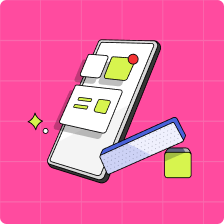Do you remember the first time you spent your own money? Felt good, didn’t it? Receiving your first allowance is a rite of passage. Not only does it mark a new phase in the parent-child relationship, one that’s evolving away from constant supervision toward more freedom of choice, but it’s the first time your kids might handle money of their own.
Entering the world of chores and allowance with your kids comes with responsibility and a few very important teachable moments (this is money management, after all). But guess what? It doesn’t have to be complicated.
In this guide, we’ll break down why kids should have an allowance, how chores and allowance go together, what age to start an allowance, the three types of allowance, amount of allowance by age, and how to talk to your kids about financial literacy.
We’ll also look at how a money management app for kids, like Mydoh, makes beginning a weekly allowance or monthly allowance easy by letting parents set up regular allowance payments from their account to their child’s.
Read on to learn how to get started.
What is an allowance for kids?
An allowance is giving your kids a set amount of money on a regular basis (either a monthly allowance or a weekly allowance) in exchange for completing chores or with no labour required. The best approach is the one that works for your family, but a hybrid of both methods is popular (more on this below).
It’s a big step for all parties involved—kids taste the freedom of having their own money to manage and parents enjoy watching them take on new responsibilities as they mature. It’s a promise between you and your children that, if kept, results in a win-win for everyone.
Why should kids get an allowance?
It can be difficult to accept that your kids are growing up; we still see their baby faces behind their morphing, maturing ones. But they are, and it’s important to give them the opportunity to prove it to you. An allowance is a clear-cut way to demonstrate responsibility. You enter into a deal—we give you x amount, you do y.
Using a chore and allowance app that focuses on money management can be a good way to ease into an allowance routine. Mydoh provides parents with oversight, so you can still have some control over how your kids spend their money, thanks to the transparency between accounts. Kids have the freedom to manage their money, while parents have the ability to monitor how they’re doing. You can even react to purchases with emojis (think about using the applause emoji when they make a good decision).

4 reasons why parents should give an allowance
1. Allowance builds confidence
Managing your own money is a big step, and kids recognize this. Taking pride in paying for something on your own feels good at any age. Watching your kids’ confidence grow as they learn how to navigate money is rewarding for you too.
2. Allowance creates teachable money moments
It’s up to you if you want to give total spending freedom, but whether you monitor purchases or not, it’s important to talk to your kids about what they plan to do with their money. Discuss spending needs versus wants, saving early for something they want, donating money to a cause close to their heart, and buying gifts for others.
3. Allowance encourages responsibility
Giving kids money to manage on their own says, I trust you to handle this because you’re responsible. This can boost feelings of importance and self-worth. That’s powerful.
4. Allowance creates a safe space to mess up
Spending regret happens at any age, but by giving kids a low-stakes space to learn through trial and error, they understand how to deal with it early. When they spend all their allowance on candy, for instance, they’ll realize they can’t buy that game they really want. When that happens, you can have a conversation about how that makes them feel and what they might do differently next time.
3 types of allowance
Let’s break down the types of allowance and how they work. One of the first things to consider is frequency: Will you choose a weekly allowance or a monthly allowance? It’s important to be consistent and deliver on your end of the promise in a timely manner, regardless of the type of allowance you decide on. Mydoh makes it easier to remember because when your kids complete a task and mark the task as completed in their account, they’ll get paid on Pay Day, which happens every Saturday.
Here are the three types of allowance.
1. Chore-based allowance
This version is probably the most familiar—a child is assigned household chores and promised a certain amount of money upon completion. The chore can be anything from a daily task, like loading the dishwasher, to a weekly duty, like taking out the recycling, to an as-needed job, like washing the car.
Chores depend on the age of your child; you are the best judge regarding what they can accomplish, but it’s important that they can accomplish it. Assigning a chore that’s too difficult to complete properly doesn’t help anyone—you will have to redo it and your kid will feel like they failed.
Pros: Paying children money for doing chores is classic and, to be honest, it helps keep the house clean (there’s that win-win!). It teaches the value of earning money for a job well done. Chores can also teach kids important life skills.
Cons: Some argue that children should contribute around the house because they are part of the family; plus, they live there too. Does paying them undermine this value?
2. Pure allowance
This concept focuses on teaching kids about financial responsibility by paying an allowance regardless of household duties. Your kids may do chores, but that is not why they are receiving money.
Pros: Separating the chores from the allowance helps kids understand that chores are a part of family life. It still teaches them money management without the added pressure of “If I don’t vacuum the living room, I won’t get paid.”
Cons: Some feel that paying an allowance without tying it to a specific task doesn’t teach kids the lesson of earning money for doing a great job.
3. The hybrid approach
Blending the two methods offers the best of both worlds. Kids receive an allowance that’s not tied to chores, as well as the opportunity to earn extra cash through larger tasks like washing windows or weeding the garden. This approach teaches money management and gives them an incentive to earn even more.
Pros: This approach works especially well with older kids who can comfortably complete larger household tasks—including babysitting younger siblings. It’s flexible for parents, so they can decide how chores are completed and how they’re rewarded in their home.
Cons: Depending on the child’s ambition, parents may run out of tasks for them to do. You can always put a limit on how much extra allowance can be earned.
At what age should you give your child an allowance?
Many kids are ready to handle regular chores and payments by around age 10. But the decision is personal, and what age to start allowance depends on the child. Some factors to consider are interest and maturity level. Has your child been asking specifically for an allowance or for certain items you aren’t prepared to pay for? Do you feel they are ready to take on a new responsibility? You know your kid best.

How to determine which allowance type is right for your family
As mentioned above, some families believe chores and allowance should be as separate as church and state, while others feel it’s a simple way to help kids learn about the value of work. Both can be true, hence the hybrid option, but how do you decide?
1. Figure out what type of allowance you want to give
By the time your kids are ready for an allowance, they’re probably already handling some regular chores such as tidying their room, feeding a pet, or emptying the dishwasher. How is that going? Do you think a cash incentive will help your child complete these tasks faster or, let’s be honest, with less complaining? Maybe a chore-based allowance is a good fit. If the chores are already being done and you have a nice routine established, try a pure allowance.
2. Assess different kid’s needs
What works for one child may not work for another, and there is nothing wrong with having different allowance types between siblings. An older teen may be better suited to a hybrid with larger tasks; a young tween may benefit more from a straightforward approach where they complete a few chores each week and then collect an allowance. Mydoh makes it easy to set this up—you create a task like “feed the dog” and assign it to your child. When they’re done, you will get an alert through the app.
3. Determine how much freedom to give
This is a big one. Young tweens starting with their first allowance may require more monitoring as they navigate having their own spending money. On the other hand, you may want to give them total freedom to see how they do first. They may surprise you! You could consider setting limits to what they can buy, like no violent video games.
How to set an allowance for your kids
Once you’ve decided what type of allowance you will be giving, it’s time to talk numbers. It’s important to be fair and set an amount that will give your child the chance to buy even something small, as well as save and donate a portion.
1. Look at your expenses
How much can you spare for allowance from the household expenses? Crunch the numbers and leave room for an increase as your children age. Will you be able to keep up your end of the bargain with multiple children?
2. Determine an allowance amount by age
A good rule of thumb is 50 cents to $1 for every year of the child’s age per week or twice a month. For example, a 13-year-old would receive $6.50 to $13 per week or $26 to $52 per month.
• Allowance recommendations for kids under 10 years old: Start small with younger children, so they get a feel for having their own money. Try a range of $2 to $5 a week.
• Allowance recommendations for tweens 10 to 12 years old: Once they’ve proven they can handle their money, it’s time for a raise. As kids age, they may want more expensive things. Try a range of $5 to $12 a week.
• Allowance recommendations for teens 13 to 16 years old: Older teens will need a step up; try a range of $13 to $16 a week. If your teen has a part-time job, you can decide if that warrants lowering or even removing the allowance altogether.
Use our kids allowance calculator to help assign chores determine how much money to give your children.
3. Decide when you will pay out the allowance
Choosing between a monthly allowance and a weekly allowance is personal. A good recommendation is to start with a weekly allowance or twice-monthly allowance so kids can see their funds add up more quickly. Receiving money every week gives kids something to look forward to—Pay Day! And with Mydoh, Pay Day is every Saturday. You just set the amount and frequency, and the money automatically goes to your child’s account and Smart Cash Card.
4. Set expectations around giving and receiving allowance
The important thing is to communicate clearly what you expect from your child in order for them to receive their money, whether that’s daily chores, grades, or behaviour. If you’re doing the hybrid method, clarify which tasks will receive payment and which ones should be done to help the family. Taking away allowance as punishment is not recommended because it might cause undue pressure and anxiety. And let your child know that they can earn increases as they age—it’ll give them something to look forward to.
Looking for seasonal chore ideas for your kids? Read our articles on spring chores, winter jobs for kids and summer chore list.

Important money conversations to have with your kids and teens
Before you begin an allowance, teach kids about money at an early age with the whole family—even young kids five and under can grasp the basic concepts.
Here are some conversation starters.
1. Explain that almost everything costs money, like the water they use to brush their teeth, electricity, internet, and gas. Kids often have trouble visualizing the big picture when talking about family finances. You can help them understand that it’s a privilege to have money to spend on the things they want after covering the things they need.
Explaining socioeconomic differences can also be helpful for kids. One key learning might be not to brag about your allowance to others, as some kids do not have this privilege.
2. The concept of spend, save, give is popular because it emphasizes that allowance is not just for frivolous spending (although it is OK to treat yourself now and then!). Managing money is about more than buying what you want—it’s about developing a healthy relationship with finances for life.
• Save: Saving 10 per cent a month is a good start. Your kids may want to earmark what they’re saving for. Teach them the value of saving money for a contingency fund; they may be interested in starting a savings account with higher interest (explain interest to them as well, if that’s the case).
• Spend: Here’s the fun part! You may want to put parameters around what they can buy—do they have free rein, or are some things off-limits? Talk to them about quality versus disposable items and the value of their money. If you buy three poorly made sweaters at $10, is that more valuable to you than buying one sweater at $30 that will last? Being open and available for money conversations takes the confusion away. Let them know they can ask you anything.
• Give: Donating 10 per cent is a good rule of thumb. It teaches philanthropy and is a great life lesson in helping others. You can research a cause together and set up a regular contribution; they can save up for a large donation or make a new donation every month. It’s up to them! Consider donating to community initiatives sometimes. This will help teach kids the value of putting their money back into where they live, learn, and play.
The benefits of using a money management app for chores and allowance
While there are some pros to giving a cash allowance to kids, the truth is that they’ve been well exposed to the digital world by the time they’re kids and teens. It can be easier to spend online when the money doesn’t feel real, and this is actually a great reason a money management app like Mydoh can be helpful. It teaches kids how to deal with digital finances right out of the gate—something we as parents never had the opportunity to learn until adulthood. Kids live their whole lives online, so why should their finances be any different?
Everything is self-contained and monitorable in the Mydoh app. You open a parent account, invite your kids, and set a recurring amount. Parents can enter tasks and assign values to them, or send money with no task completion required. If you decide to include tasks, you will get an alert when your child says they’ve completed one. The Smart Cash Card can be locked and unlocked at any time, and all purchases are visible. Kids can spend online and in-store (up to the allowable limits) anywhere Visa is accepted by using their Smart Cash Card.
Are you ready to talk about chores and allowance with your kids?
No matter how you plan to structure allowance, the most important thing is to consider the pros and cons of an allowance and chores—from deciding what type of allowance suits your family to planning conversations about good money habits, responsibility, and philanthropy. Your kid or teen is ready for more responsibility. Are you?
This article offers general information only and is not intended as legal, financial or other professional advice. A professional advisor should be consulted regarding your specific situation. While the information presented is believed to be factual and current, its accuracy is not guaranteed and it should not be regarded as a complete analysis of the subjects discussed. All expressions of opinion reflect the judgment of the author(s) as of the date of publication and are subject to change. No endorsement of any third parties or their advice, opinions, information, products or services is expressly given or implied by Royal Bank of Canada or its affiliates.






















